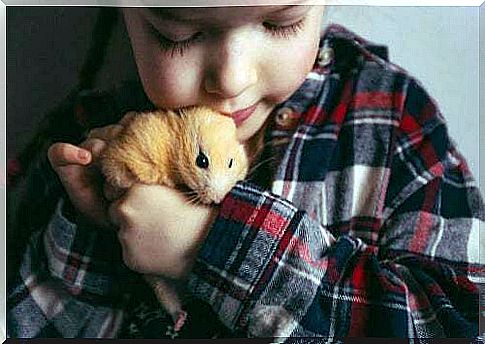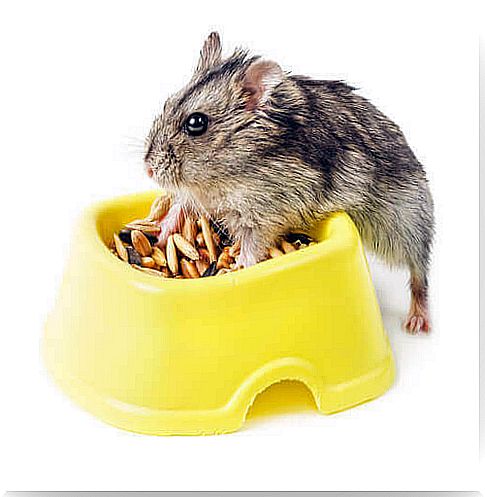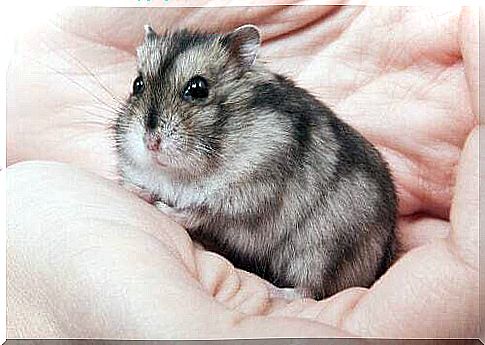How To Communicate With A Hamster: A Guide

Hamsters are ideal pets for those living in a small house. They are also ideal for those who want the company of a pet but don’t have the opportunity to spend a lot of time with them. To make these pets happy, good communication with them is essential. So let’s see how to communicate with a hamster.
Hamsters live between 2 and 4 years on average. The attention they need is very little compared to that required by a dog or a cat. In fact, getting them out of the cage and exercising for about five minutes will be enough.
Because they are so small, hamsters don’t eat large amounts of food and you also have to be careful about how much food you offer them. These small rodents are quite sensitive, so it is essential that communication between pet and owner works properly. Here’s how we can communicate with a hamster.
Communicating with a hamster hamster with food
The best way to train a hamster is to breed it from an early age. In this way, you can use food to educate him, make him calm and understand his behaviors.
The correct nutrition of the hamster consists of a diet rich in minerals, fiber, low in fat and with many vitamins. All this will be necessary for your rodent friend to survive for a long time.
These properties can be found in cereals and seeds, which contain the fiber necessary for the diet. In the case of vitamins, they help make the hamster full of energy. Also, fruits and vegetables are recommended.

All these foods must be offered to the hamster in small quantities and with caution. Food remnants that remain in the cage and spoil could cause damage to the hamster’s health. Therefore, dry food that you can easily find in pet stores is highly recommended, as it does not expire easily.
What is strictly forbidden in a hamster’s diet are: salt, chocolate, fat and sweets in general. It is also best to avoid eating wet vegetables, parsley, grapes, carrots, beets, or frozen vegetables.
Communicating with the hamster through trust
In addition to food, there is also another way to communicate with the hamster and that is through the voice and hands. In fact, this can show the rodent that they can trust you.
For people who have enough free time to devote to it, it is advisable to take their little friend in their hands, without squeezing him tightly, but with enough strength to prevent him from escaping. The next thing to do will be to observe what the hamster does.
Another way you can communicate with a rodent is to make sounds that are only used with him or, occasionally, talk to him from a distance. This way, the little rodent will start jumping towards your hands to be cuddled. Here’s how hamsters communicate with people.
The body language of the hamster
In addition to these guidelines we have seen, there are other elements of the hamster’s body language as well – they can be observed by the way it moves.

When he slowly stretches his body, it means that your little friend is happy and relaxed. However, if he is compulsively moving, twitching, or lying on his back, it is because he feels a threat and is afraid.
Hamsters cope with fear and the feeling of threat by tucking their ears or keeping their tails erect.
If the hamster jumps, digs and carries objects from one place to another in the cage, it means that he is in a good mood. In case the hamster brings a lot of material into his nest, he may be preparing to have his young and this is a time when you should leave him alone.
When the hamster doesn’t want to get caught, he may just be tired and it’s time to let him rest in his cage. When he yawns or proves to be irritable, it is advisable to let him rest. Let’s see how hamsters communicate with people.
The hamster communicates through sounds
Another way a hamster communicates with its owner is through sounds. When a hamster snorts, screams or grinds its teeth it means that it feels threatened.
When he squeals and growls, he is communicating aggression and the need for space and tranquility. Some females also emit soft beeps to call their young to eat or because they want them to be close to her.
Keep in mind that hamsters are very territorial and love to rub their bellies to mark their territory. They are also nocturnal animals, so it is best not to let them stay in too bright places in the house.









